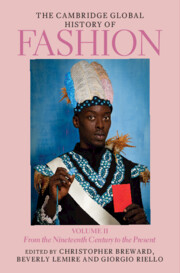Book contents
- The Cambridge Global History of Fashion
- The Cambridge Global History of Fashion
- The Cambridge Global History of Fashion
- Copyright page
- Contents for Volume II
- Figures for Volume II
- Maps for Volume II
- Table for Volume II
- Contributors for Volume II
- Preface
- Part IV Fashion, Modernism, and Modernity
- Part V Fashion, Colonialism, and Post-Colonialism
- Part VI Fashion Systems and Globalization
- 35 Manufacturing Fashion in the Post-War Period
- 36 Producing and Predicting Fashion in Twentieth-Century America and Europe
- 37 The Origins and Development of Haute Couture, 1858 to Now
- 38 Couture, Prêt-à-Porter, and Fast Fashion since 1945
- 39 Casualwear and Its Birth in Japan
- 40 Fashion and Globalization
- 41 Streetscape, Shop Window, Museum Vitrine
- 42 Fashion and Global Sustainability
- Index
- References
36 - Producing and Predicting Fashion in Twentieth-Century America and Europe
from Part VI - Fashion Systems and Globalization
Published online by Cambridge University Press: 04 August 2023
- The Cambridge Global History of Fashion
- The Cambridge Global History of Fashion
- The Cambridge Global History of Fashion
- Copyright page
- Contents for Volume II
- Figures for Volume II
- Maps for Volume II
- Table for Volume II
- Contributors for Volume II
- Preface
- Part IV Fashion, Modernism, and Modernity
- Part V Fashion, Colonialism, and Post-Colonialism
- Part VI Fashion Systems and Globalization
- 35 Manufacturing Fashion in the Post-War Period
- 36 Producing and Predicting Fashion in Twentieth-Century America and Europe
- 37 The Origins and Development of Haute Couture, 1858 to Now
- 38 Couture, Prêt-à-Porter, and Fast Fashion since 1945
- 39 Casualwear and Its Birth in Japan
- 40 Fashion and Globalization
- 41 Streetscape, Shop Window, Museum Vitrine
- 42 Fashion and Global Sustainability
- Index
- References
Summary
In a bold cultural move, some style-conscious American activists of the twenty-first century have engaged with the material history of the civil rights movement (1954–68) to make a powerful statement about clothing, class, and community. Whether commemorating historic 1960s marches or fighting for racial justice as part of Black Lives Matter (BLM), activists have taken to the streets in their ‘Sunday best’: sharply tailored suits for the men, and fancy party dresses for the women. Casting aside the oversized t-shirts, gym shorts, and baseball caps that have become synonymous with street style, elegant protesters have looked back to the 1960s when the dapper Dr Martin Luther King Jr (1929–1968), the future US Congressman John Lewis (1940–2020), and countless other American activists proudly embraced the dress code of respectability that earmarked white middle-class culture of the modern era.
- Type
- Chapter
- Information
- The Cambridge Global History of FashionFrom the Nineteenth Century to the Present, pp. 1249 - 1291Publisher: Cambridge University PressPrint publication year: 2023



